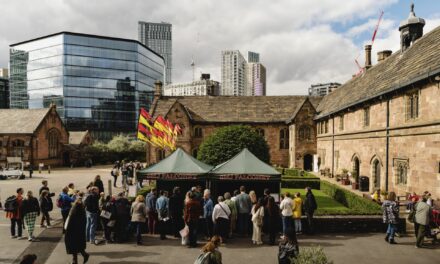It’s only young but the British Textile Biennial has woven its place into the fabric of mill towns across Lancashire.
The theme of BTB23 is the Politics of Cloth, but let’s start with the politics of transport. Those without a car may struggle to visit all on offer – with such a rich and varied set of exhibitions, seeing everything may not be possible. At Blackburn Museum (ignore the scaffolding, they’re mending the roof), a tiny swatch of disintegrating cloth, the size of your mobile phone, brings you to the heart of the Politics of Cloth. This is the Penistone Cloth. In 1783, this sample was sent to an English slave owner who subsequently bought 410 yards to clothe his slaves in Barbados. Using this as a starting point, BTB23 and The Global Threads Research Team tell the story of the making of this fabric and its place in the colonial history of the cotton industry.

Photo by Matthew Savage
Next, there’s Blackburn’s Cotton Exchange for Victoria Udondian’s monumental work, Ofong Ufok, which she developed with members of New York’s immigrant communities who wove and knotted their individual garments, memories, stories and skills into this towering artwork. In the same space, Nairobi’s Nest Collective has constructed a room from bales of used garments, discarded by Europeans and shipped to African nations.
Around the corner from the Cotton Exchange is Tony’s Ballroom. This splendid old nightclub is full of its own histories and memories but, for BTB23, it plays host to Dead White Man where artist Jeremy Hutchison has constructed wonderfully wearable, yet slightly sinister sculptures from garments sent from the Global North to various nations of Africa. There, they are called dead white man’s clothing.
Meanwhile, Uthra Rajgopal has playfully filled every space in The Whitaker Museum for Fragments of our Time. Some 17 artists from South Asia and its diaspora considered sustainability in the context of the environment, economics and society. Each piece makes you pause for thought. It’s difficult to highlight one without mentioning all of them, but Yasmin Jahan Nupur’s delicate handwoven, hand-dyed muslin ‘curtains’ with embroidered texts guide you through the space with their strikingly simple messages. This show extends beyond BTB23 to December 10, 2023.
If you’ve missed out on this extravaganza, you can listen to the Cloth Cultures podcasts, made in association with Amber Butchart where she interviews many of the people who have worked to create this year’s set of exhibitions and stories.
Main image: Ofong Ufok by Victoria Udondian. Photo by Matthew Savage.








